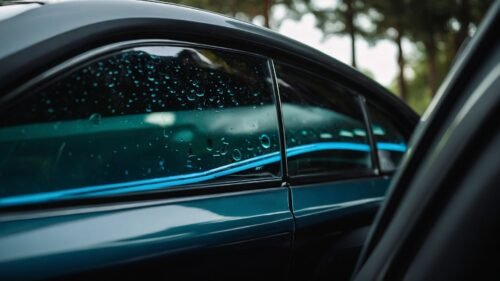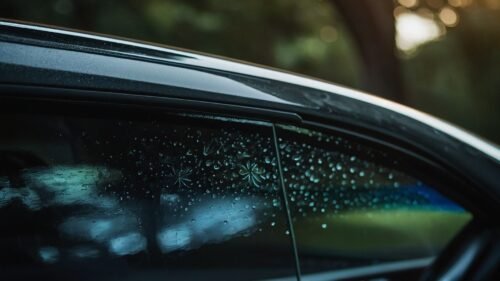When it comes to tinting your vehicle windows, choosing the right tint level is crucial for achieving the desired benefits.
Two popular options that often arise in this decision-making process are 35 tint and 20 tint.
In this comprehensive guide by 4WheelersClub, we’ll delve into the distinctions between these two tint levels, helping you determine which one aligns best with your preferences and requirements.
Related:
Chevy Traverse Service Battery Charging System Light
Table Of Contents
Understanding Tint Levels

35 Tint
With 35% tint, you allow 35% of visible light to pass through your vehicle’s windows. This level of tint provides moderate privacy and heat rejection while ensuring good visibility both during the day and at night.
20 Tint
On the other hand, 20% tint permits only 20% of visible light to penetrate the windows. This darker tint offers increased privacy and heat reduction compared to 35 tints but may slightly compromise visibility, particularly at night.
Factors that should be considered
Legal Regulations
To properly proceed with the window tinting, one must know the local laws and regulations about tint levels.
These vary by location and give the highest possible percentage of tint allowed for different windows on a vehicle.
Personal Preference
Your personal preference has an important role in determining suitable tint levels.
When you are deciding, consider factors such as desired privacy, heat reduction capacity, glare reduction capability, and aesthetic appeal.
Climate and Environment
The level of tint you choose could also be influenced by the climate or environmental conditions in your area.
In a hot and sunny place like where I live, there is an increased need to reduce heat; thus darker tints are more attractive at 20%.
On the other hand, if visibility is compromised because of foggy weather or frequent night drives then it is easier to choose light tints like 35%.
Vehicle Type
The kind of car you have can affect your choice of tints as well.
Bigger cars with more space inside may require darker tints for added comfort and privacy while smaller ones might be better off having lighter ones so that they do not compromise visibility.
Benefits of Tinting Windows

Tinted windows are beneficial for the following reasons regardless of the tint level chosen:
UV Protection: The 35 and 20 tints protect from harm caused by ultraviolet rays. They keep your skin and interior upholstery safe from sun damage.
Heat Reduction: Your car’s interior temperature can be well regulated by tinted windows, which minimize heat build-up while enhancing general comfort mainly in hot summer seasons.
Privacy: With tinted windows, one gets more privacy since it cannot be easily seen by those outside.
Glare Reduction: Tinted windows help to reduce the glare that comes from the sun, headlights, or other sources making driving easy for you due to reduced eye strain as a result of this action.
35% vs. 20%
Visual Comparison
To see how these two options differ in terms of opacity and darkness, we should visually check vehicles with 35% and 20% tints.
They both have different levels of privacy and offer different degrees of sunlight protection, however; outside appearance-wise, the twenty percent one seems considerably darker than the thirty-five percent one.
Heat Rejection
About heat rejection, slightly better performance is achieved in case twenty percent tint is used instead of thirty-five percent tint because of its higher level of opaqueness.
Nevertheless, there may not be significant differences between these two window film types when it comes to their ability to reduce heat during daily driving activities.
Legal Compliance
To avoid charges and fines, you must make sure that the shade of your choice is legally acceptable in the respective regions.
In some regions, however, 20 tints might be beyond some jurisdictions.
FAQs (Frequently Asked Questions)
– Are vehicle windows tinting legal?
Yes, car window tinting is legal in most places but there are rules regarding the darkness of tint allowed on different windows.
– Will I see at night if I have my windows tinted?
But still, darker shades such as 20% can reduce nighttime vision to some extent; yet proper fitting and maintenance can minimize this effect.
– How long does it last typically?
The lifespan of a window film depends on certain things such as the quality of film used for tinting, the method of application, and environmental conditions. Good quality materials can go up to ten years with good care.
– Can I do it myself or should I consult an expert?
Commercial services guarantee proper accomplishment and adherence to legal requirements although do-it-yourself kits are available for purchase online.
– Do window films provide security advantages?
Also, these darkened glasses prevent outsiders from seeing valuables inside a car making it possible to deter potential thieves.
Conclusion
In the debate between 35 tints vs 20 tints, there’s no one-size-fits-all answer. A combination of personal preference, legal considerations, and environmental factors should guide your choice.
By weighing the pros and cons of each tint level and understanding their respective implications, you can make an informed decision that enhances your vehicle’s comfort and aesthetics.
Credits – AIRPM
